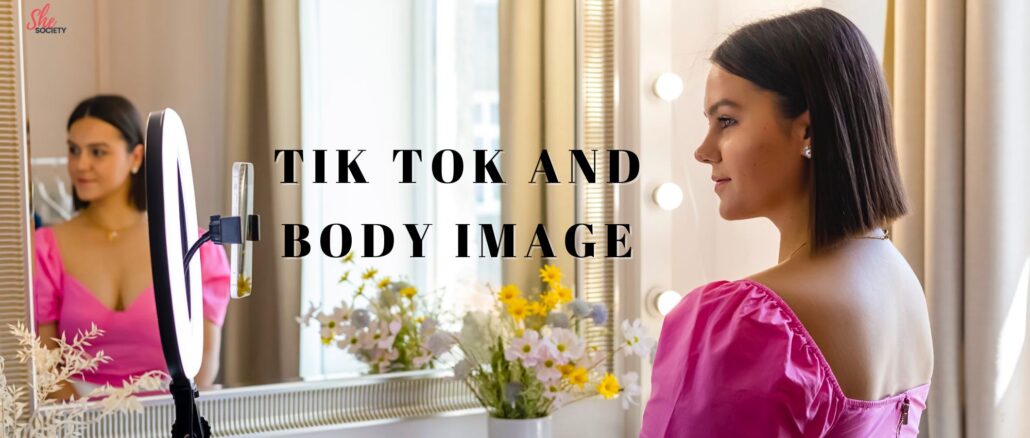
Short-form social media videos and images that set unattainable appearance standards may harm young women’s perception of body image, research suggests.TikTok and body image: idealistic content may be detrimental to mental health
Short-form social media videos and images that set unattainable appearance standards may harm young women’s perception of body image, research suggests.
TikTok videos that reflect unrealistic depictions of physical appearance may harm how young women think and feel about their bodies – and the impacts may be worse if the content is perceived as unedited and natural.
Research published recently in the Journal Body Image suggests that just a little exposure to short-form social media videos reflecting unattainable appearance standards – known as appearance-ideal content – is enough to have a negative impact on body image.
Appearance ideals are what our culture tells us about how we should aspire to look. With few exceptions, this is a narrow representation of physical appearance and beauty, for example, long legs, toned stomachs, large eyes, full lips, and blemish-free skin.
While these standards are not necessarily new, social media is an environment where users tend to view and show the most attractive versions of themselves and others. TikTok, which exclusively utilises short-form video content, can be an especially appearance-focused environment, with many viral trends like dance challenges reflecting widely held societal conceptions of beauty.
“Appearance-ideal content can pressure women to look a certain way that is unrealistic or completely unattainable,” says Dr Jasmine Fardouly, senior author of the study from the School of Psychology at UNSW Science. “We know this starts early, with girls as young as six reporting unhappiness with their bodies, desires to look thinner, and even dieting to lose weight.”
Appearance dissatisfaction, frequently reported among young women, is associated with adverse mental health outcomes, including depression, and is a risk factor for some clinical eating disorders.
“Social media isn’t the only place where these appearance ideals are promoted, but there is a lot more opportunity to internalise them through the platforms,” Dr Fardouly says.
Negative impacts on body image
For the study, the researchers showed 211 women aged 17 to 28 ten images or videos selected from the Instagram and TikTok accounts of young female social media influencers that reflected societal appearance ideals. They then surveyed the participants on several body image measures, using appearance-neutral content – content without people – for comparison.
“We found that appearance-ideal short-form video content on social media, regardless of the medium, can have adverse effects on appearance satisfaction, negative mood, and self-objectification among participants,” says Jade Gurtala, an honours graduate in psychology and lead author of the study.
The research also found participants made the same amount of upward appearance comparisons when they viewed ideal content in images or video. In other words, they compared their own bodies to the women in the appearance-ideal content, judging themselves as less attractive, negatively impacting their mood and increasing body dissatisfaction.
“The total exposure time was only like a minute and a half, and we found that was enough to have harmful impacts,” says Dr Fardouly. “That was just in a lab-based setting, so it’ll be interesting to measure the impact of exposure over the long-term and whether that has some cumulative effect.”
Emergence of editing and enhancements
Appearance ideals promoted through social media are often enhanced and edited using manipulation techniques like hyper-realistic face and body filters that are becoming harder to detect, particularly with video.
While the exact nature of any enhancements applied to the content in the study was unknown, participants perceived the video content they viewed to be less edited and enhanced than the images and were less satisfied with their own appearance by comparison.
“If appearance-ideal video content is perceived as unedited and enhanced when it in reality is, then users may be more likely to engage in negative social comparisons and internalise the appearance ideals,” Ms Gurtala says. “So, viewing ideal video content may be more harmful than viewing ideal image content for some users.”
On average, study participants reported spending between two to three hours on social media each day. The researchers say reducing daily screen time or diversifying the type of content we consume may help minimise overall exposure to appearance-ideal content.
“There’s also a role for the platforms, which can have very pervasive algorithms that promote appearance ideals and keep users engaged, to help expand the range of content shown to users in their social media feeds,” Ms Gurtala says.
Further research is also needed to determine if there are potential positive effects of viewing short-form video content featuring diverse and unedited containing unedited bodies.
“Some evidence suggests image-based content that challenges these beauty ideals and promotes body positivity, body function, and body acceptance help to make social media a less harmful environment for body image,” Dr Fardouly says.
In the meantime, the findings can inform media literacy guides that play a significant role in educating young women about the impacts of social media use on body image and countering unrealistic representations of appearance.
“It’s important to update these educational body intervention programmes given the emerging evidence around the negative impacts of appearance-ideal video content, especially as it evolves and becomes a more dominant medium on social media,” Dr Fardouly says.
SheSociety is a site for the women of Australia to share our stories, our experiences, shared learnings and opportunities to connect.

Leave a Reply